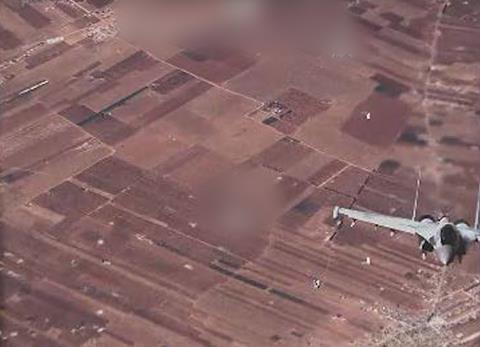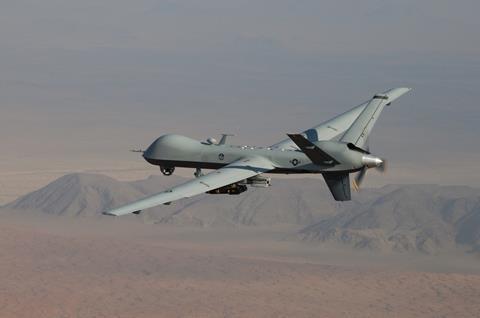Russian fighter jets intercepted an American military unmanned aerial vehicle (UAV) over Syria, marking the latest escalatory incident in the conflicted airspace where both countries are operating.
The US Air Force’s (USAF’s) Middle East headquarters on 5 July said three Russian Sukhoi Su-35 fighters engaged in “unsafe and unprofessional behaviour” around 10:40 local time in the vicinity of multiple General Atomics Aeronautical Systems MQ-9 Reaper combat UAVs being operated by the American military.

“While three US MQ-9 drones were conducting a mission against ISIS targets, three Russian fighter jets began harassing the drones,” US Air Forces Central (AFCENT) says. “Against established norms and protocols, the Russian jets dropped multiple parachute flares in front of the drones, forcing our aircraft to conduct evasive manoeuvres.”
One Russian pilot positioned his Su-35 in front of an MQ-9 before engaging the afterburner, affecting the ability of the Reaper’s pilot to safely operate the remotely flown craft, AFCENT says.
Grainy photos released by the USAF show an Su-35 flying in close formation to the filming aircraft, which AFCENT says was one of the MQ-9s. Other photos show thermal and optical images of parachute flares drifting over brown farmland and a village of two-storey buildings.
“These events represent another example of unprofessional and unsafe actions by Russian air forces operating in Syria, which threaten the safety of both US and Russian forces,” says AFCENT commander Lieutenant General Alex Grynkewich.
“We urge Russian forces in Syria to cease this reckless behaviour and adhere to the standards of behaviour expected of a professional air force so we can resume our focus on the enduring defeat of ISIS.”
Washington’s forces are engaged in a multi-year campaign of active combat against the terrorist group ISIS – also known as the Islamic State – including special operations forces on the ground supported with rotary aviation transport and fixed-wing close air support.
Moscow’s forces are supporting the Syrian government in Damascus in a long-running civil war, which has often served as a proxy war between the USA and Russia.

The two sides maintain a so-called deconfliction line in Syria, meant to prevent any inadvertent hostilities between the two nuclear-armed countries in a zone crowded with armed military aircraft.
Moscow did not immediately respond to the criticism from the USAF. However, on 6 July, the Russian defence ministry announced the start of joint drills between the Russian and Syrian air forces.
“Servicemen of the two countries perform tasks on controlling airspace of the Syrian Arab Republic,” Moscow says. “Effectiveness of air defence system of the Russian Group of Forces in Syria is to be inspected.”
The drills, which will run until mid-July according to Moscow, will also include electronic warfare units performing “combined actions on repelling mock enemy airstrikes”.
The 5 July incident is just the latest in what Washington has described as increasingly frequent and increasingly aggressive actions by Russian forces in Syria.
In June, the Pentagon deployed an unspecified number of its vaunted Lockheed Martin F-22 air superiority fighters to the Middle East, specifically citing recent Russian activity.
“Russian Forces’ unsafe and unprofessional behaviour is not what we expect from a professional air force,” said the USA’s top officer in the region, General Michael Kurilla, in announcing the so-called show of capability.
“Their regular violation of agreed upon airspace deconfliction measures increases the risk of escalation or miscalculation,” Kurilla added, without providing specifics.
In March, a Russian air force Su-27 collided with another American MQ-9 over the Black Sea, resulting in the downing of the UAV over international waters.
The Russian fighter involved in that incident landed safely, although the top USAF officer in Europe said at the time the “unsafe and unprofessional act by the Russians nearly caused both aircraft to crash”.
In September 2022, another Russian Su-27 fighter in the Black Sea region released an air-to-air missile in the vicinity of a UK Royal Air Force (RAF) Boeing RC-135 Rivet Joint surveillance aircraft, in what Moscow described as a technical malfunction.
The incident drove London to mandate Eurofighter Typhoon escorts for RAF flights in the area.


























